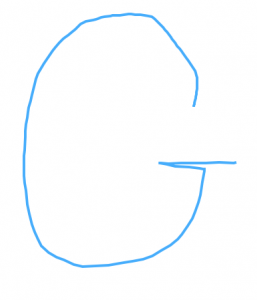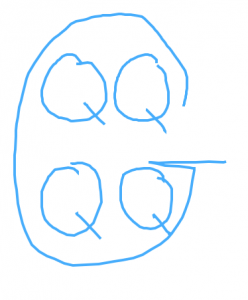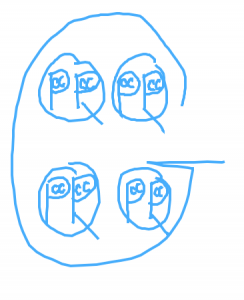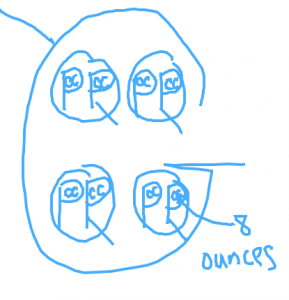Posts Tagged as "fifth grade"
Gallon man to the rescue!
Thursday, June 3rd, 2010Do you need a way to remember unit conversion effortlessly and forever? Or just a way to calculate how many cups there are in a gallon?
Here’s how to figure it out. Draw a gallon man!
First, draw a really big capital G. (This is the gallon.)

Inside the G, draw four big Qs. (These are the quarts.)

Inside each Q, draw two Ps. (These are the pints.)

Inside each P, draw two cs. (These are the cups.)

For the final flourish, draw an arrow to one of the cs and write “8 ounces.” (There are eight ounces in every cup.)

When one of my students, a fifth grader, taught me about Gallon Man, I thought, I wish I had learned about this in fifth grade! My entire life, I’ve had to look up each of the conversions and never really internalized how they all fit together.
Since I’ve been introduced to Gallon Man, I’ve gleefully shared him with a fourth grade tutoring student (online), a friend who is a professional organic farmer (in person), innocent bystanders (at a restaurant), and most recently, my Mom (over the phone…”first, draw a really big G…”)!
They’ve all found Gallon Man helpful. Responses have included: “Can I take that drawing home with me?”, “Oh…I get it!”, and “I’m going to hold onto this.”
Gallon Man is totally visual and works for many learning styles. You can SEE how many quarts are INSIDE a gallon. Gallon Man is intuitive for all grade levels (unlike dimensional analysis, you don’t have to worry about the numerators or denominators). Gallon Man is practical. You can use it in your kitchen or in the grocery store. Gallon Man is easy to remember. And Gallon Man is fun to draw!
Gallon Man has recently gotten some airtime from other math bloggers, including Sam J Shah, who pointed out that it really helped him to see someone drawing Gallon Man. Here’s Sam’s post and video.
Yay for mnemonic devices!
*Are you looking for an online math tutor who uses multisensory methods? I’d love to help! Give me a call at 617-888-0160 to discuss your situation.
*Visiting from the Math Teachers at Play Carnival (Adventure Edition)? Welcome, I’m glad to see you here! Below are a few other posts you might enjoy!
Related posts:
Tips for how to help your kid with their math homework
Doing Fractions “In Chinese”?!
An easy way to remember how logarithmic notation works
Case study: a homeschooler prepares for the SAT
Comment on this post (9)








